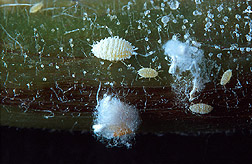This page has been archived and is being provided for reference purposes only. The page is no longer being updated, and therefore, links on the page may be invalid.
|
Background: |
Parasitic Wasps Could Curb MealybugBy Jennifer ArnoldAugust 17, 2001 In an ongoing search for a biological control for papaya mealybug (Paracoccus marginatus), researchers have singled out two parasitoid wasps for the job. The researchers are entomologist Michael Schauff at the Agricultural Research Service and John Noyes, a colleague at The Natural History Museum, London, England, The papaya mealybug is believed to be native to Mexico and Central America and has the potential to attack a variety of agricultural crops, including papaya, citrus, cotton and avocado, in addition to preying on ornamentals, such as the hibiscus. The papaya mealybug was recently introduced into the United States, with the greatest concentrations of the insect being in Florida, Puerto Rico and the U.S. Virgin Islands. Mealybug damage could cause economic losses in the tens of millions of dollars if left to spread in the United States. The two candidate wasps, newly discovered species in the genera Pseudleptomastix and Acerophagus, were collected during field research in Texcoco, Mexico, in 2000. These tiny wasps are almost invisible--with one species just about one millimeter long--and look like the average stinging wasp. Dubbed the "mealybug destroyers," the tiny females sting the mealybugs and lay an egg inside each one. When the eggs hatch, the larvae eat the internal organs, killing their hosts. ARS scientists, in conjunction with USDA Animal and Plant Health Inspection Service scientists who have reared and released the wasps in the Caribbean, are now seeing a tremendous impact. They are confident a parasite-release operation can be an effective tool in the war against papaya mealybugs. Already, APHIS found that the release of the parasitic wasps brought a 98 percent reduction in mealybugs near the research sites. In some areas, scientists are even having trouble finding enough to work on. And the wasps pose no threat to people, plants or any insects other than the papaya mealybug. ARS is the U.S. Department of Agriculture's chief scientific research agency. Entomologist Schauff is based in Beltsville, Md., with ARS' Systematic Entomology Laboratory. |

